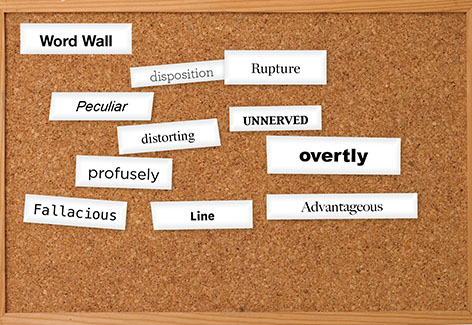What?
When?
During and after reading
Why?
Word walls support a language-rich learning environment. They foster word-consciousness and provide access to essential vocabulary, concepts and skills. Word walls reinforce sight-word acquisition with younger readers and build content literacy across grades and disciplines. Word walls help students see relationships between words and ideas.
How?
Organize your word wall vocabulary based on learning objectives and on the relationships among the words. For example, group words that are relevant to women’s suffrage or words that are synonyms for tolerance.
Word walls should reflect the character and culture of the classroom. Use index cards, sentence strips or construction paper on a wall, window or door. Lettering should be large, neat and visible from every seat in the classroom.
Before adding a word to the word wall, teachers should ensure that students understand its meaning in the context of the text. A variety of steps can be employed to achieve this:
- Have students use context clues, affixes or roots, or word relationships. Use reference materials when meaning cannot be determined using these other means.
- Prior to reading, provide definitions for words that cannot be determined from the context or explain unknown concrete and abstract words when encountered in the text. Abstract words will take more time and should be reinforced after reading.
In addition to the word wall displays, reinforcement could be achieved through vocabulary flash cards, organizers and repetitious activities that explore shades of meaning and morphology. Continued practice will enhance students' abilities to acquire and use a range of academic (Tier Two) and domain-specific (Tier Three) words.
Adapt and expand your word wall so that students can reference the words throughout the year. Alternately, rotate word walls with each new lesson or unit. Applications like Worldle, WordItOut and WordSift, can help create digital word walls. Bright colors and pictures engage students and illustrate a wall’s overall theme.
English language learners
Organizing word wall vocabulary into categories or word families helps build context and associations among words. Post phrases, including idioms and transition words, and include accompanying visuals whenever possible. Separating Tier One, Two and Three vocabulary offers another level of differentiation. English language learners should practice speaking the words on the wall.
Connection to anti-bias education
Your word wall tells students what you consider worth learning. Including vocabulary related to diversity signals that students may safely talk about personal or controversial topics in your classroom. Along with academic words, consider integrating these:
- Identity-centered or culturally affirming words (e.g., cornrows, tortilla)
- Difficult or sensitive words (e.g., racism, atheism)
- Words that describe power dynamics (e.g., gentrification, solidarity)
- Words and terms that matter but are not in the textbook (e.g., stop and frisk)
Students can also contribute to the word wall; enlist students with artistic or spatial skills.

